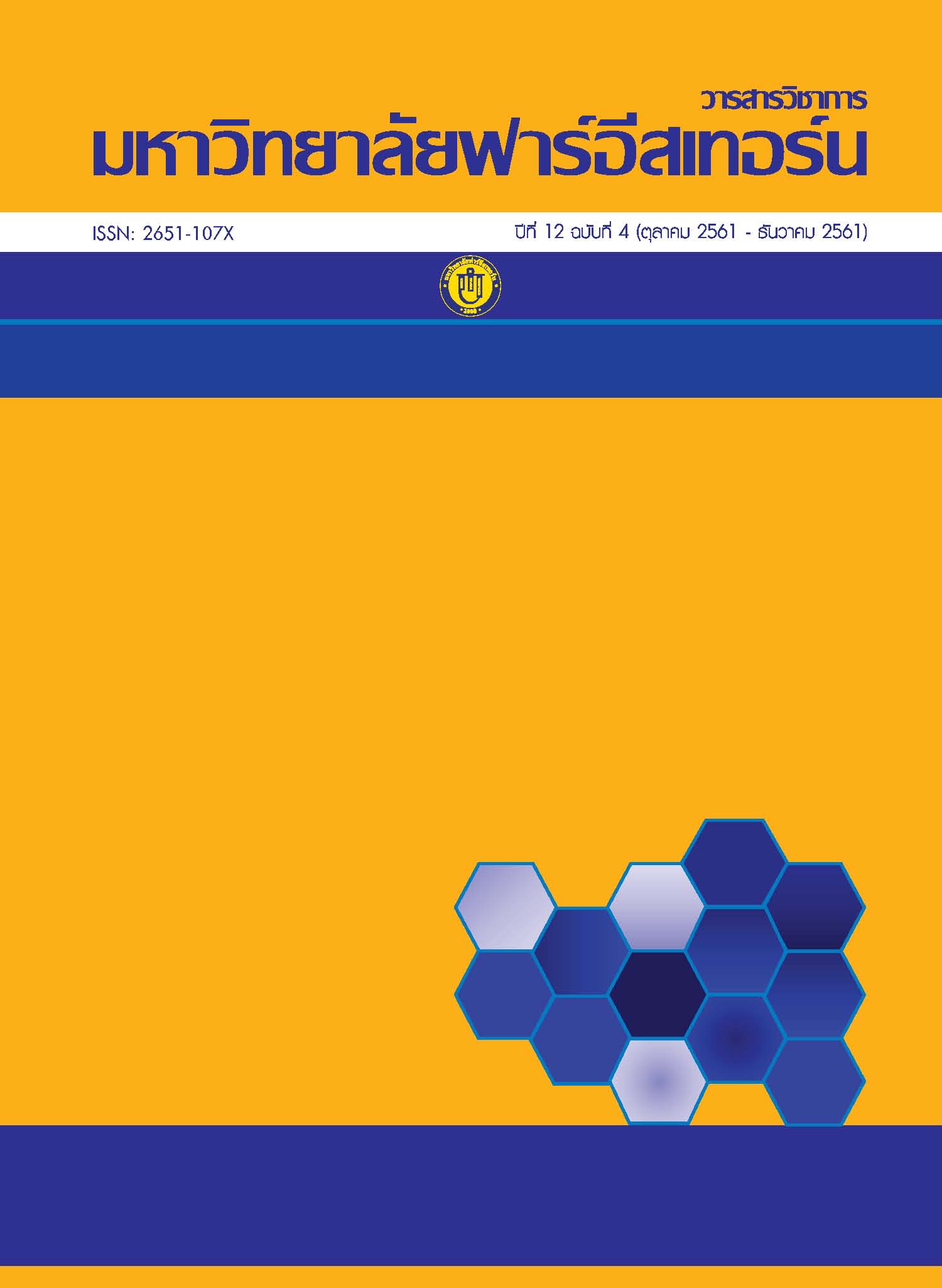รูปแบบความสัมพันธ์เชิงสาเหตุความภักดีของลูกค้าธุรกิจค้าปลีกประเภทไฮเปอร์มาร์เก็ต จังหวัดลำปาง
Main Article Content
บทคัดย่อ
การวิจัยนี้มีวัตถุประสงค์เพื่อ (1) ศึกษาผลกระทบของส่วนประสมทางการตลาดบริการ ความพึงพอใจของลูกค้า และความเชื่อมั่นที่มีต่อความภักดีของลูกค้า และ (2) ค้นหารูปแบบโมเดลความสัมพันธ์เชิงสาเหตุความภักดีของลูกค้าธุรกิจค้าปลีกประเภทไฮเปอร์มาร์เก็ต จังหวัดลำปาง โดยทำการเก็บรวบรวมข้อมูลด้วยแบบสอบถามด้วยวิธีการสุ่มแบบเจาะจงจากลูกค้าที่ใช้บริการธุรกิจค้าปลีกประเภทไฮเปอร์มาร์เก็ต จังหวัดลำปาง จำนวน 384 ชุด โดยใช้สถิติพรรณนา และสถิติอนุมานวิเคราะห์โมเดลสมการเชิงโครงสร้าง ทดสอบสมมติฐานความสัมพันธ์ระหว่างตัวแปร ผลการวิจัยพบว่า การตรวจสอบความสอดคล้องกลมกลืนของโมเดลกับข้อมูลเชิงประจักษ์ผ่านและอยู่ในระดับดี โดยมีค่า X2 = 4.850, p = 0.088, X2/df = 2.425, GFI = 0.995, CFI = 0.998, RMR = 0.005, RMSEA = 0.061 ซึ่งแสดงว่า ผลกระทบของความพึงพอใจของลูกค้ามีอิทธิพลต่อความเชื่อมั่น, ส่วนประสมทางการตลาดบริการมีอิทธิพลต่อความพึงพอใจของลูกค้า และความพึงพอใจของลูกค้ามีอิทธิพลต่อความภักดีของลูกค้า ยกเว้นส่วนประสมทางการตลาดบริการและความเชื่อมั่นไม่มีอิทธิพลต่อความภักดีของลูกค้า และส่วนประสมทางการตลาดบริการไม่มีอิทธิพลต่อความเชื่อมั่น ดังนั้น ลูกค้าที่เข้ามาใช้บริการธุรกิจค้าปลีกประเภทไฮเปอร์มาร์เก็ต ให้ความสำคัญในเรื่องของความพึงพอใจจากการใช้บริการ และให้ความสำคัญต่อปัจจัยการให้บริการของธุรกิจด้านการอำนวยความสะดวก และความเอาใจใส่ของธุรกิจผู้ให้บริการจนเกิดเป็นความภักดีเพื่อเข้าใช้บริการในครั้งต่อ ๆ ไป
Article Details
1. ทัศนะและข้อคิดเห็นใดๆ ในวารสารนวัตกรรมสังคมและการเรียนรู้ตลอดชีวิตเป็นทัศนะของผู้เขียน กองบรรณาธิการไม่จำเป็นต้องเห็นพ้องด้วยกับทัศนะเหล่านั้นและไม่ถือว่าเป็นความรับผิดชอบของกองบรรณาธิการ
2. ความรับผิดชอบด้านเนื้อหาและการตรวจร่างบทความแต่ละบทเป็นของผู้เขียนแต่ละท่าน กรณีมีการฟ้องร้องเรื่องการละเมิดลิขสิทธิ์ถือเป็นความรับผิดชอบของผู้เขียนแต่เพียงฝ่ายเดียว
3. ลิขสิทธิ์บทความเป็นของผู้เขียนและมหาวิทยาลัยฟาร์อีสเทอร์นได้รับการสงวนสิทธิ์ตามกฎหมาย การตีพิมพ์ซ้ำต้องได้รับอนุญาตโดยตรงจากผู้เขียนและมหาวิทยาลัยฟาร์อีสเทอร์นเป็นลายลักษณ์อักษร
เอกสารอ้างอิง
การบอกต่อ และการกลับมาใช้บริการซ้ำของลูกค้าห้างสรรพสินค้าสุขอนันต์ปาร์ค.
กรุงเทพฯ: มหาวิทยาลัยกรุงเทพ.
Nichapa Saengnin. (2015). The Influences of marketing mix on trust, satisfaction, word of
mouth and repurchases of the Suk-Anan Park’s customer. Bangkok :
Bangkok University.
ธิตินันธุ์ ชาญโกศล. (2558). รูปแบบความสัมพันธ์เชิงสาเหตุของปัจจัยส่วนประสมทางการตลาดบริการที่มี
ผลต่อ ความรับผิดชอบต่อสังคมและคุณค่าตราสินค้าในใจผู้ใช้บริการธุรกิจค้าปลีก
ประเภทไฮเปอร์มาร์เก็ต ในประเทศไทย. วารสารบัณฑิตศึกษา มหาวิทยาลัยราชภัฏวไลยอลงกรณ์,
9(2), 22-36.
Thitinan Chankoson. (2015) A casual relationship model of service marketing mix affecting
the corporate social responsibility and brand equity on consumer-based within
the retail business: hypermarket in Thailand. Journal of Graduate Studies Valaya
Alongkorn Rajabhat University, 9(2), 22-36.
ศิริวรรณ เสรีรัตน์, ปริญ ลักษิตานนท์ และศุภร เสรีรัตน์. (2552). การบริหารการตลาดยุคใหม่. กรุงเทพฯ :
พัฒนาศึกษา.
Siriwan Sareerat, Parin Luksitanon and Suporn Sareerat. (2009). Modern Marketing
Management. Bankok : Phatanasuksa.
อนุวัต วงสม. (2557). การพัฒนาโมเดลความสัมพันธ์เชิงสาเหตุความภักดีของลูกค้ากิจการค้าปลีก
สมัยใหม่ในพื้นที่จังหวัดสงขลา. การประชุมหาดใหญ่วิชาการระดับชาติและนานาชาติ
ครั้งที่ 5 วันที่ 16 พฤษภาคม 2557 ณ มหาวิทยาลัยหาดใหญ่, 30-40.
Anuwat Songsom. (2014). Developing the Causal Relationship Model of Modern Trade
Customer Loyalty in Songkhla Province. The 5th Hatyai National and International
Conference, 16th May 2014, 30-40.
อรรถพล ฐิติวร. (2558). อิทธิพลของส่วนประสมทางการตลาดต่อความไว้เนื้อเชื่อใจ
ความพึงพอใจ และความจงรักภักดีของลูกค้าธนาคารไทยพาณิชย์ จำกัด (มหาชน)
สำนักงานเขตพื้นที่ ถนนรัชดาภิเษก (ท่าพระ). หลักสูตรบริหารธุรกิจมหาบัณฑิต
สาขาวิชาการจัดการทั่วไป มหาวิทยาลัยเทคโนโลยีราชมงคลพระนคร.
Attapon Thitivaorn. (2015). The Influence of marketing mix on trust, satisfaction and
customer loyalty of Siam Commercial Bank, Ratchadapisek (Thapra) Area Office.
Master of business administration of General management, Rajamangala University of
Teachnology Phra Nakhon.
Adel, P. (2015). The impact of marketing mix elements on brand loyalty: A case study of
mobile phone industry. Marketing and Branding Research, 2, 44-63.
Bateson, J. E. , & Hoffman, K. D. (2011). Services Marketing (International Edition) (4th ed.).
South-Western, Cengage Learning.
Cochran, W. G. (1977). Sampling Techniques (3rd ed.). New York : John Wiley and Sons Inc.
Byrne, B. M. (1989). A Primer of LISREL: Basic Applications and Programming for
Confirmatory Factor Analytic Models. New York: Springer-Verlag.
Hair, J.F. , Black, W. C. , Babin, B. , Anderson, R. E. , & Tatham, R. L. (2006). Multivariate
Data Analysis (6th ed.). Upper Saddle River, New Jersey : Prentice-Hall.
Hansemark, O. C. , & Albinson, M. (2004). Customer Satisfaction and Retention: The
Experiences of Individual Employees. Managing Service Quality, 14 (1), 40-57.
Ivanauskiene, N. , & Auruskevicien, V. (2009). Loyalty programs challenges in retail banking
industry. Economics & Management, 14, 407-412.
Kotler, P. , & Armstrong, G. (2010). Principle of marketing (13th ed.). New Jersey: Pearson
Prentice Hall.
Kotler, P. , & Armstrong, G. (2014). Principle of marketing (15th ed.). New Jersey: Pearson
Prentice Hall.
Kotler, P. , & Keller, K. L. (2012). Marketing management (14th ed.). New Jersey: Pearson
Prentice Hall.
Lamb, C. W. , Hair, J. F. , & McDaniel, C. (2000). Marketing. United States: South – Western
College Publishing.
Lassar. W. , Mittal, B. , & Sharma, A. (1995). Measuring customer-based brand equity.
Journal of Consumer Marketing, 12, 11-19.
Likert, R. (1970). A technique for the measurement of attitudes. In G.F. Summer (Ed.)
Attitudes measurement. New York: Rand McNally.
Oliver, R. L. (1999). Whence customer loyalty? Journal of Marketing, 63, 33–44.
Rempel, J. K. , Holmes, J.G. , & Zanna, M. P. (1985). Trust in close relationships. Journal of
Personality and Social Psychology, 49, 95-112.
Seyed Rajab Nikhashemi, Laily Haj Paim, Samsinar Md Sidin, Ali Khatibi. (2014). Driving
Forces of Hypermarket’s Customer Loyalty: An Empirical Study in Malaysia.
Australian Journal of Basic and Applied Sciences, 8(3), 377-386.
Yelkur, R. (2000). Customer satisfaction and the services marketing mix. Journal of
professional services marketing, 21(1).
Zhicheng, Q. , & Foosiri, P. (2012). The Factors Influencing Low-Cost Airline Passenger
Satisfaction and Loyalty in Bangkok, Thailand. Master of Business Administration
International College University of the Thai Chamber of Commerce.

